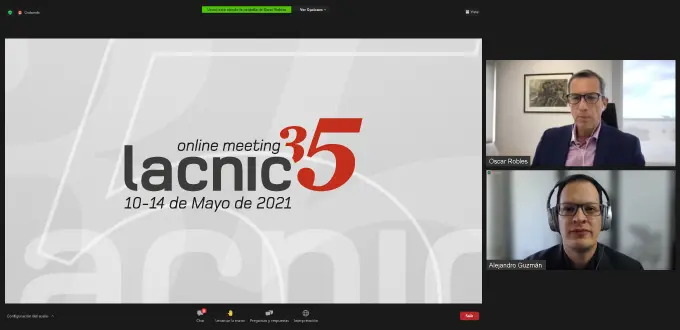Growth of IPv6 and RPKI Deployment in the LACNIC Region
12/05/2021

One in four Internet packets circulating in Latin America and the Caribbean uses the IPv6 protocol; in the case of RPKI (a system that helps Internet providers to verify the right to use a resource) 33.5% of LACNIC’s ASNs have been certified. These numbers were reported by LACNIC CEO Oscar Robles during his presentation at LACNIC 35.
According to the chart presented by Robles, IPv6 deployment has been steadily growing in the region, even more so after IPv4 exhaustion in August 2020.

Robles pointed out that IPv4 address exhaustion increased all types of requests as well as address transfers and stated that 2021 began with “the highest level of activity in LACNIC’s history.” In this sense, he described the number of address requests as “good news,” as it shows that activity remains strong within the LACNIC community.
Last year, 1,527 new members joined the organization responsible for managing Internet number resources in the LAC region, driving LACNIC’s current membership base up to a total of 11,840.
IPv4 Address Transfers. Robles presented a balance of IPv4 address transfers both within the region and with other RIRs. The net balance of the transfers made within the LACNIC region shows that Argentina is the country that transferred the most addresses (100k), while Mexico is the one that received the most (52k). As for inter-RIR transfers, Argentina is also the country that transferred the highest number of IP addresses (28k), while the United States is the one that received the highest number of addresses (25k) from the LACNIC region.
On another note, Robles highlighted the fact that LACNIC’s services, as measured by a bi-annual survey conducted by international consultants MERCOPLUS, achieved a 98% overall level of satisfaction, a record number in LACNIC’s history.
He concluded his presentation by observing that 2020 had been a challenging year fraught with uncertainty which had led LACNIC to test its resilience and its ability to attend to its responsibilities creatively and with responsibility towards its collaborators, its members, and the community as a whole.
(Free access, no subscription required)

In turn, during his presentation at LACNIC 35, Alejandro Guzmán, President of the LACNIC Board, noted that most of the Board’s work had been related to issues that have a direct impact on the community. Almost a third of the Board’s time was devoted to community related issues such as the ratification of policies, community participation in the discussion of those policies, and analyzing the implications of each policy for LACNIC and their impact on the community. Other aspects of the Board’s work had to do with the various elections, event planning by the organization’s staff, assessing the results of each of these meetings, and support for future meetings.